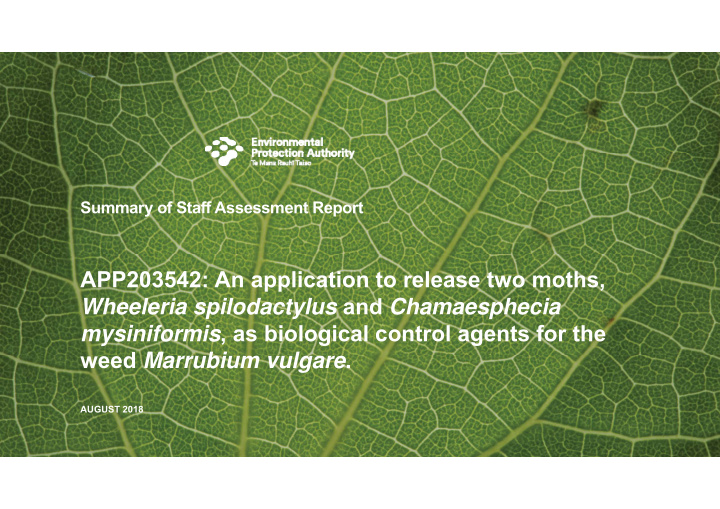



Summary of Staff Assessment Report APP203542: An application to release two moths, Wheeleria spilodactylus and Chamaesphecia mysiniformis , as biological control agents for the weed Marrubium vulgare . AUGUST 2018
The application 2 The Horehound Biocontrol Group lodged an application with the EPA on 15 May 2018 seeking pre-approval to release Wheeleria spilodactylus and Chamaesphecia mysiniformis , as biological control agents for the weed Marrubium vulgare . The application was publicly notified. The EPA received 40 submissions: 39 submitters supported the application and one opposed the application. Eight submitters indicated they wished to present their submissions at a hearing .
Wheeleria spilodactylus Chamaesphecia mysiniformis 3 Clearwing moth Plume moth Biocontrol agents Target weed Marrubium vulgare Horehound
Distribution of horehound in New Zealand 4
Risk/Benefits assessment 5 We assessed the risks and benefits of bringing the plume moth and the clearwing moth into New Zealand, assuming the successful establishment of self-sustaining populations. We assessed the risks and benefits to • the environment, • market economy, • public health, • people and communities, and • Māori and their relationship with the environment.
Assessment of risks Assessment of benefits 6 Potential environmental risks Potential environmental benefits No BCA BCA More herbicide use Less herbicide use Reduced biodiversity Improved biodiversity Fewer new sites invaded No BCA BCA Decontamination of soil Impact on non-target species Disruption of food webs Worse weeds may establish Potential economic risks Potential economic benefits No BCA BCA More herbicide use Less herbicide use Increased cost of crops Cost-effective Decreased wool value Increase in wool value Reduced productivity Increase of pasture productivity BCA No BCA Less herbage available More herbage available for medicinal use
Environmental benefits 7 Limit the invasion of new sites Highly likely to have major beneficial effects Improved biodiversity Likely to have minor beneficial effects in pastoral areas and major beneficial effect in unmanaged habitats Reduced use of herbicides Likely to have minor beneficial effects but highly likely in the long term We assessed the environmental benefits of the introduction of the two biocontrol agents to range from low to high.
Economic benefits 8 Reduced cost of herbicides likely to have minor beneficial effects Increased pasture productivity highly likely to have major beneficial effects Increased wool value highly likely to have major beneficial effects We assessed the economic benefits of the introduction of the biocontrol agents to range from low to high.
Environmental risks 9 Attack non-target species • Phylogenetic relationship between horehound and other plants • Narrow host range confirmed by experiments • Plume moth has high host specificity (2 species in tribe Marrubieae) • Clearwing moth (6 species in 2 tribes included in the sub-family Lamioideae) • In New Zealand, 5 indigenous species in the Labiatae family highly improbable that the 2 moths would attack non-target native plant species. We assessed that, if off-target attacks should occur, then these would be incidental and cause minimal effects.
Environmental risks 10 Disruption of food webs and insect interactions • Poor fauna associated with horehound • Not main source of nectar for honey bees • No native moth species in the same genus • Presence of potential parasitic insect Very unlikely to disturb horehound-fauna and would have minor effects Replaced by worse weeds Likely to have a minor impact We assessed the adverse environmental effects from the introduction of the two biocontrol agents in New Zealand’s environment to be negligible.
Economic risks 11 Reduced plant availability • Interruption in horehound infestation could be a barrier to BCA dispersal • Combination of controls • Cultivate horehound • Integrate the harvest in the weed management strategies very unlikely to adversely affect plant availability. The economic risks for herbalists is assessed to be minor We assessed the adverse effects of the introduction of the two biocontrol agents to New Zealand’s market economy to be negligible.
Potential outcomes Likelihood Consequence Conclusion Potential beneficial effects to the environment Summary of our assessment Limit the invasion of new sites, especially Highly likely Major High 12 conservation and sensitive areas Reduce the use of herbicides Likely Minor Low Increase in biodiversity in managed / Likely Minor / major Low / medium unmanaged habitats Potential beneficial effects to the market economy Reduce cost to control horehound from Likely Minor Low herbicides Increase in pasture productivity Highly likely Major High Increase in the value of wool Highly likely Major High Potential adverse effects on the environment Risks to non-target species Highly improbable Minimal Negligible Risk to ecosystem interactions and food Very unlikely Minimal Negligible webs (indirect effects) Potential adverse effects to the market economy Decrease plant availability for medical Very unlikely Minor Negligible herbalists and their businesses
Conclusion on benefits and risk assessment 13 After completing our assessment and reviewing the available information, we assessed that the adverse effects of releasing the plume moth and the clearwing moth to control horehound are negligible and the benefits are significant . The benefits from the release of the two agents outweigh the risks.
Minimum standards 14 We assessed the release of Wheeleria spilodactylus and Chamaesphecia mysiniformis against the minimum standards in the HSNO Act. Our assessment concludes that the two biocontrol agents meet the minimum standards.
Relationship of Māori to the Environment 15 Kaupāpa Kura Taiao made a cultural risk assessment of the application and concluded the benefits of the plume moth and the clearwing moth are likely to outweigh their disbenefits. The potential risks to Māori interests may be acceptable but information gaps remain. • Are the two moths able to interbreed with native moths, resulting in hybridisation and/or disruption of the native species? • Need more information on horehound as a rongoa (traditional medicine).
Recommendation 16 Our assessment has found that the benefits of releasing Chamaesphecia mysiniformis and Wheeleria spilodactylus outweigh any identified risks or costs. We, therefore, recommend that the application be approved.
For more information contact: General enquiries Phone +64 4 916 2426 Fax +64 4 914 0433 info@epa.govt.nz
Recommend
More recommend